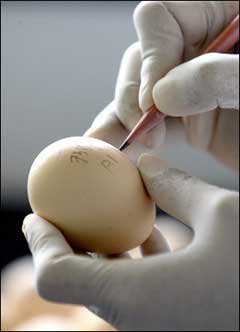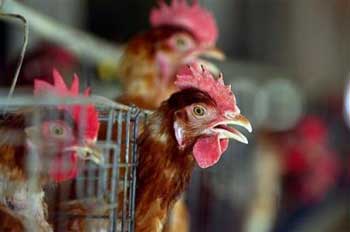CDC chief: Bird flu could become epidemic
(Agencies)
Updated: 2005-02-22 13:54
Updated: 2005-02-22 13:54
 A Thai expert writes reference numbers on an egg for tests at a laboratory in Bangkok. Thailand will begin vaccinating millions of chickens and other fowl against bird flu within the next two months to combat the lingering disease in the kingdom. [AFP] |
Dr. Julie L. Gerberding, head of the Centers for Disease Control and Prevention, said scientists expect that a flu virus that has swept through chickens and other poultry in Asia will genetically change into a flu that can be transmitted from person to person.
The genes of the avian flu change rapidly, she said, and experts believe it is highly likely that the virus will evolve into a pathogen deadly for humans.
She made the remarks in a plenary lecture at the national meeting of the American Association for the Advancement of Science.
In Asia, there have already been a number of deaths among people who caught the flu from chickens or ducks. The mortality rate is very high — about 72 percent of identified patients, said Gerberding. There also have been documented cases of this strain of flu being transferred from person-to-person, but the outbreak was not sustained, she said.
"We are expecting more human cases over the next few weeks because this is high season for avian influenza in that part of the world," said Gerberding. Although cases of human-to-human transmission have been rare, "our assessment is that this is a very high threat."
This assessment, she said, is based on the known history of the flu virus.
The avian flu now spreading in Asia is part of what is called the H1 family of flu viruses. It is a pathogen that is notorious in human history.
"Each time we see a new H1 antigen emerge, we experience a pandemic of influenza," said Gerberding. In 1918, H1 appeared and millions died worldwide. In 1957, the Asian flu was an H2, and the Hong Kong flu in 1968 was a H3.
There had been small appearances of the H1-type of avian viruses in other years, but nothing like the H5 now rampaging through the birds of Asia.
"We are seeing a highly pathogenic strain of influenza virus emerge to an extraordinary proportion across the entire western component of Asia," she said. "The reason this is so ominous is because of the evolution of flu.... You may see the emergence of a new strain to which the human population has no immunity."
 Rows of chickens at a farm in Long An province in the Mekong Delta in southern Vietnam where last year's entire flock of 23,000 needed to be destroyed from last year's bird flu on Sunday Feb.20,2005. The avian influenza, first reported in Vietnam in late 2003, swept through 10 countries in Asia last year, rampaging through poultry farms and forcing the slaughter of about 100 million poultry. Vietnam will host this week an international conference on bird flu organized by the UN's Food and Agriculture Organization and the World Animal Health Organization to stem the spread of the disease and help coordinate foreign assistance. [AP] |
"The science here is all alerting us that we have a great deal to be concerned about," she said.
The CDC chief said her agency is getting ready for a possible pandemic next year.
A special flu team, organized last year, continues to monitor the spread of the avian flu and to analyze the strains as they appear.
The government has ordered 2 million doses of vaccine that would protect against the known strains of avian flu. Gerberding said this would give manufacturers a head start on making the shots that would be needed to combat a full-blown epidemic of an H1-type of flu in this country.
CDC is also plugged into an international communication and monitoring system that, it is hoped, will give an early warning of the emergence of a deadly new flu.
But at the same time, the agency is helping to produce the 180 million or so doses of regular flu that are needed annually. Gerberding said the timeline for producing the regular vaccine yearly is very tight, with little room for problems. To produce a new vaccine in response to the sudden emergence of an H1-flu bug would require an extraordinary new effort, she said.
"We don't now have the capacity to do both," said Gerberding.
|
||
|
||
|
|
|
|